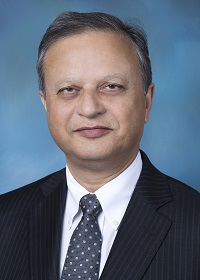Irregular Heartbeat Can Lead To Other Health Complications

Dr. M. Yousuf Kanjwal is director of clinical cardiac electrophysiology at the LifeBridge Health Cardiovascular Institute (HANDOUT)
Three to five million Americans have atrial fibrillation, an irregular heartbeat. That number is expected to increase significantly in the next decade. If left untreated an irregular heartbeat can cause life-altering complications over time. But Dr. M. Yousuf Kanjwal, the director of clinical cardiac electrophysiology at the LifeBridge Health Cardiovascular Institute, says there are successful options to control heart rate and heart rhythm.
What is atrial fibrillation?
Atrial fibrillation, also called AFib, is an irregular heartbeat where the heart beats too quickly and often chaotically so it becomes inefficient. During atrial fibrillation, the heart's electrical system, which keeps the heart pumping blood, is out of rhythm. Its top two chambers beat too fast, can beat unpredictably and are out of sync with the bottom two chambers. AFib can cause people to lose 25 percent of their cardiac output.
What are the symptoms of AFib?
Sometimes patients may not experience any symptoms, but many will complain of heart palpitations, fatigue, shortness of breath, dizziness, and/or chest pain.
What are the risks of AFib?
The catastrophic risk of AFib is a stroke. Because the heart is not pumping blood effectively and can become stagnate in one chamber of the heart, clots can form. If one clot or even a fragment of one clot is dislodged, it can travel anywhere in the body. If it moves into the brain, it can block blood flow there and cause a devastating stroke. Another risk could be congestive heart failure where the heart doesn't pump enough blood to provide organs and tissues the oxygen and nutrients to work properly. Additionally, atrial fib may be part of Sick Sinus Syndrome, which means patients can have fast and slow heart rates at different times.
What other problems can AFib lead to?
In addition to heart failure and stroke, AFib can lead to chest pain due to a fast heart rate, and extreme lightheadedness and fainting due to slow a heart rate. Besides stroke, a clot can lodge in other vessels which can cause other serious complications. Moreover, it can just be a nuisance rhythm which decreases a patient's quality of life.
How is AFib treated?
The treatment of atrial fibrillation has evolved over the years and depends on its type. If somebody has brief episodes of AFib once or twice a year, the so-called "lone fibrillators" may not receive any treatment. However, if treatment is required, there are different options depending upon the frequency and duration of atrial fibrillation.
1. Rate control and blood thinners: This strategy is usually for people who are in chronic atrial fibrillation. They are given medications to lower their heart rate and blood thinners according to their underlying risk factors; the more risk, the more chances they will need the blood thinners.
2. Drugs to maintain rhythm and blood thinners:
These drugs are a special class that can keep patients in rhythm, but there is a long-term commitment to taking them, and there are side effects. They also need to be given in conjunction with blood thinners.
3. DC Shock, or direct current shock, to restore rhythm:
Some patients may need DC shock to restore normal rhythm. However, DC shock alone does not maintain the rhythm so rhythm control medications are also needed.
4. Pacemaker and AV node ablation:
People who have chronic atrial fib and difficult to control heart rates may need a pacemaker along with a simple ablation, a surgical procedure, to block the connection between the upper and lower chambers.
5. A-Fib Ablation:
Over many years, this has become a treatment of choice for a certain group with AFib. In this invasive procedure, a cardiac surgeon goes into the heart's left upper chamber to electrically isolate the pulmonary vein that brings blood from lungs to that chamber The idea is to eliminate the trigger which is responsible for atrial fibrillation. This can be accomplished either by radiofrequency or by freezing called cryoablation. The success rate of this procedure is about 75 percent to 80 percent. This is an outpatient procedure, and individuals can resume their activities within a day or so. Some people may need second ablation.
6. Hybrid Ablation:
In this procedure, the cardiac surgeon uses a minimally invasive approach to ablate areas which are not accessible with the routine ablation. This procedure is for some of those patients with persistent and chronic atrial fibrillation.
7. WATCHMAN:
The WATCHMAN implant was recently approved by theFederal Drug Administration. It is used for patients who cannot take blood thinners and are at high risk for having a stroke. The WATCHMAN looks like an umbrella and is placed in the left atrial appendage which is a source of clots for patients with atrial fib to block off that area.
Story Credit: http://www.baltimoresun.com/health/blog/bs-hs-expert-atrial-fibrillation-20170418-story.html


